Major Base Metals, Copper, Zinc, Nickel, Lead and Aluminum, Are All in the Midst of Spectacular Secular Bull Markets
Commodities / Metals & Mining Nov 02, 2007 - 12:40 PM GMTBy: Zeal_LLC
 The global commodities bull has sure been flexing its muscles in recent years. And this is a result of our growing world's insatiable demand for the hard commodities that feed widespread industrialization and modernization. Since these commodities are finite in nature, an economic imbalance has emerged that has showcased incredible market activity.
The global commodities bull has sure been flexing its muscles in recent years. And this is a result of our growing world's insatiable demand for the hard commodities that feed widespread industrialization and modernization. Since these commodities are finite in nature, an economic imbalance has emerged that has showcased incredible market activity.
Supply has simply not been able to keep up with fast-growing demand. And when you have more capital chasing after fewer goods, prices are naturally going to rise. The industrial metals or base metals that are indispensably used in virtually every aspect of physical infrastructure, from structural to mechanical, have displayed this basic economic principle to the highest degree.
The five major base metals, copper, zinc, nickel, lead and aluminum, are all in the midst of spectacular secular bull markets that have seen each of them shatter their previous all-time highs. At their recent bull-to-date highs these metals have risen 575%, 537%, 1,124%, 888% and 145% respectively. These numbers are simply astonishing, and based on these metals' current fundamentals they are likely not done yet.
The majority of these raw metals are brought to market via mining (recycle rates vary for each metal, but are still usually a minority source to mine production). And mining today is harder than it has ever been. I wrote an essay several weeks back outlining the challenges of gold mining . And base metals miners are indeed subject to the same issues the gold miners face.
Without getting into these details it is imperative to understand that the mined production of any mineral can only react so fast to changes in demand. Because mining is so capital- and time-intensive it takes years to increase output. Hence the secular nature of these metals bull markets.
So with supply being pinched, above-ground stockpiles of these metals that consumers have consistently relied upon have been reduced to historical lows. This now-structural supply deficit has drastically raised prices and has shaped increasingly volatile markets. And this has created a haven for adrenalin-junkie speculators.
In watching these bull markets unfold it has been eye-opening to see how the fundamental, technical and speculative natures of these metals converge to make their markets. And the best way to capture the essence of a bull is to look at it in a visual format. Whether you are a futures or stock trader it is important to consider the technical nature of an asset via its chart history.
And the base metals have sure been exciting from a technical perspective. With the gains mentioned above, as you can imagine there has been some extreme volatility. This volatility has been most apparent on the upside, but of course there has been some exciting downside action intertwined in these bulls.
The last time we took a look at base metals technicals each of the metals was regrouping after a massive 2006 rally. Some were continuing to crash/correct, some were consolidating, and some were not giving up their ghosts and driving even higher.
In each of these scenarios the metals remain at strong price levels that defy the notion that 2006's strong year for the base metals marked the pinnacle of their bulls. After such incredible gains last year even some base metals pundits were calling for an across-the-board crash that would wipe clean most of the bull-market gains. Let's see how 2007 has panned out so far.
I'll start with copper, as it is the proverbial king of the base metals as far as the markets are concerned. Ever since its early 2006 parabolic surge to an astonishing $4 it has captured mainstream attention. Even today CNBC still flashes its ticker on the same banner as gold and silver.
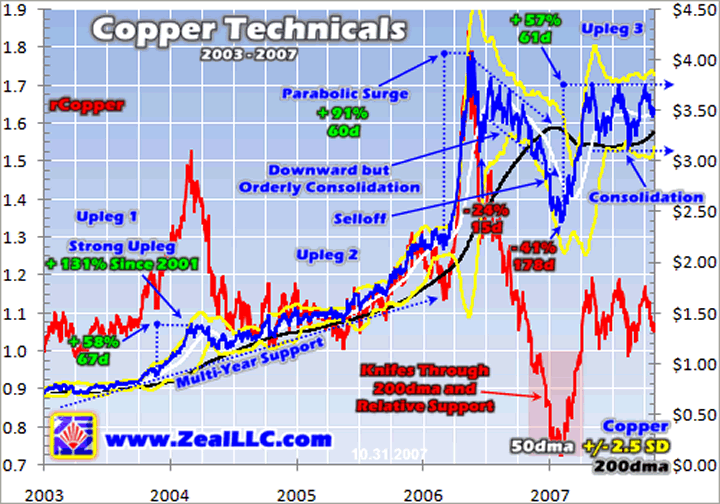
When looking at copper technicals and attempting to gain a grasp on where the metal is going, we first need to look at where it came from. Since copper's bull really began in 2003 there are what appear to be two distinct uplegs that have run their courses. The first upleg ended in March 2004 with a strong 67-trading-day surge that vaulted the price of copper 58%.
And the key fundamental driver of this first upleg is what has set the tone for the greater base metals bull markets. China is this driver and its growing consumption of copper had really overwhelmed the global marketplace. In 2003 China 's insatiable demand for this metal spurred the gutting of its own stockpiles and the subsequent attack on the remaining global copper stockpiles.
This was evident as witnessed by the massive copper draws from the largest non-ferrous metals exchange in the world, the London Metal Exchange (LME). LME copper stockpiles didn't just slowly decrease, they plummeted until they hit their June 2005 lows of about 40k metric tons and simply couldn't go any lower. The alarmingly low stockpiles that resulted from China 's pillaging was equivalent to only about one day of global consumption. This just terrified the markets.
And it was this continual descent of the global stockpiles that warranted the short-lived and weak correction off upleg 1's top. In no time at all copper jumped right into upleg 2. And the second half of upleg 2 was truly an amazing display of how extremely bullish fundamentals can capture the attention of investors and speculators so much that their excitement percolates into a euphoric trading environment.
Upleg 2 began in orderly fashion and spent the first year or so in a beautiful uptrend that rode copper's multi-year support. During this time, in May of 2005, copper surpassed its previous historical high achieved in 1988. And then for about the next year or so copper never looked back.
The second half of upleg 2 was just magnificent. As copper gained more and more interest, an increasing amount of speculative capital bid on this metal. Even the hedge funds were jumping aboard and throwing massive amounts of capital at copper and the rest of the base metals. With above-ground inventories of copper at such historically low levels, a growing speculative risk premium was placed on its price.
This premium accelerated into a dazzling parabola that peaked in May of 2006. In just 60 trading days copper climbed 91% to briefly exceed its $4 interim top. After a quick 24% bled off the top, copper entered into a six month or so downward consolidation before it bottomed at just under $2.50 at the beginning of this year.
During this 41% run lower copper became the plague of the metals arena. For the first time in copper's entire bull it decisively knifed through its 200dma support and scared the pants off many folks. Commodities bears and bulls alike proselytized the end of the base metals bull market. Even some of the better-known experts in this field launched truculent criticism on the core fundamentals of copper's bull. Boy were they wrong!
In all actuality, copper's retreat was not only necessary but fundamentally warranted. It was necessary to crush the exuberant greed that engulfed this commodity. And it was warranted due to a shift in fundamentals. In this stretch of time copper stockpiles reversed trend and actually grew for the first time in years.
From the apex of upleg 2 to copper's interim low in February 2007, LME copper stockpiles doubled to exceed 200k metric tons. As more of a cushion was built into copper's above-ground supply, naturally the speculative risk premium subsided. Interestingly there is an incredibly strong inverse correlation between price and stockpile levels for most of the base metals. And copper has been abiding by this rule even through today.
From its bottom in February, copper stockpiles began to retreat yet again and copper turned the corner to perhaps begin upleg 3. A quick 57% gain in just 61 trading days vaulted copper above $3.50 before it settled into a $3+ sideways trend that continues today. Copper stockpiles have been teetering in the low 100k metric-ton level during this sideways grind waiting to see what happens on the global fundamental front.
It will be interesting to see which side of today's trend channel copper eventually breaks out of. Since the price of copper has not exceeded its previous interim high achieved in upleg 2, it is still up in the air whether copper is on the path of another major upleg that will surpass its previous high or if this will just be a consolidation upleg.
One thing that is apparent is copper's bull is not over. As LME stockpile levels oscillate in the 100k to 200k metric-ton level, traders are realizing that this is still historically low. Just in 2002 LME copper stockpiles were at 1000k metric tons. Demand is still hot and suppliers are struggling to keep pace.
As above-ground copper stockpiles stay low speculators will continue to add a risk premium to copper's price. And the markets are seemingly now willing to accept $3 copper as a righteous level in today's environment. These levels would have been laughed at just a few years ago. But since copper originally broke $3 a year and a half ago its average daily price is in excess of $3.30. Ultimately if it breaks its trend channel on the upside, $4 copper should fall fast yet again.
Zinc is another of the base metals riding an incredible bull market. And looking at its chart it has a very close technical resemblance to copper up through the first half of 2006. Like copper, zinc has seen an incredible increase in demand to support the global industrialization we see today, primarily driven by Asia . But the fundamental drivers of zinc's technical scene have recently resulted in a price behavior different than that of copper.
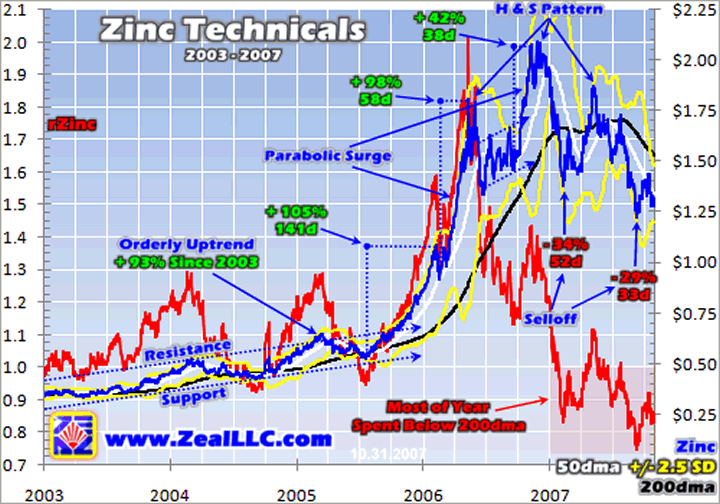
Like copper, zinc had an orderly long-term uptrend up through the middle of 2005. After a minor five-month pullback that took zinc to its July low of $0.53, it entered into an upleg of epic proportion. This upleg spawned three very powerful surges that took the metal to price levels that are simply mind-blowing. And the drivers behind this upleg were of course a result of bullish fundamentals mixed with a little speculative fervor.
Like most of the base metals, above-ground zinc inventories were pilfered with reckless abandon. As stockpiles dwindled and suppliers continually fell short of meeting growing demand, fear gripped the zinc markets. Rising prices were natural in this supply imbalance, and speculators were quick to bid it up. A skyrocketing speculative risk premium was apparent is zinc's swift ascent.
The first surge grew in semi-parabolic fashion in which zinc doubled from its July 2005 low in just 141 trading days. In this initial surge zinc crossed the $1 barrier for the first time ever and has not looked back since. After a brief reprieve zinc surged to double yet again in only 58 trading days. In less than a year zinc soared nearly 250% before halting with the rest of the metals in May of 2006.
And here is where zinc bucks the trend from most of the rest of the metals. While many in the metals complex (including precious metals) saw May of 2006 as a major interim stopping point and cooled from their rallies by entering into long downtrends and/or consolidations, zinc was not quite finished with its upleg.
After its second surge zinc shed 26% in 18 trading days. But with stockpiles continuing to fall, fundamentals again called for speculators to grow zinc's risk premium. Zinc followed its surge-two correction with an upward-trending consolidation and then surged yet again eclipsing its surge-two high. In just 38 trading days zinc tacked on another 42% and amazingly exceeded $2.
This third surge brought zinc to its current interim high. After hitting this high in November of 2006 zinc has been trending down. What sparked zinc's decline was first that it was overbought, but second that the plunging of the LME stockpiles started to ease. In unison with zinc's high, LME zinc stockpile levels flattened in the ensuing months. This allowed the speculators to loosen the risk premium.
Now looking at zinc's chart you can see that a classic head-and-shoulders pattern has emerged over the last year and a half. The correction off the head saw zinc fall 34% in 52 trading days. Zinc then rallied a little to form the high of the right shoulder and then interestingly began to sell off again.
I say interestingly because from the peak of the right shoulder LME stockpiles again started to fall. Since April zinc stockpiles have fallen to their lowest level in years. These levels are so low now that there is the equivalent of only about two days of daily global consumption. This alone should terrify traders. But as you can see zinc has had a rough last six months.
In fact a recent 33-day selloff that saw zinc go down another 29% appears to have pierced the visual neckline of this head-and-shoulders pattern. Unfortunately this type of pattern is common in the chart-technician world as a trend-reversal pattern.
So for a variety of reasons zinc's price actions are perplexing me. First, the inverse correlation to LME stockpile levels has been broken of recent. And second, an overtly bearish chart pattern has emerged. Thankfully in the real world fundamentals always trump technical nuances.
Zinc's bull market is not over. There is still a huge economic imbalance in the zinc trade. And even though it is hard to conceptualize zinc in a market slump because it is still quadruple what it was at the beginning of its bull, it should turn up eventually. It will be interesting to see where zinc goes from here.
Now though the base metals have many similarities in their fundamentals and technicals, they also have their differences. While we are indeed in a base metals bull market, each of the individual base metals is carving a unique bull market of its own. And unique only begins to describe nickel's thrashing bull market.
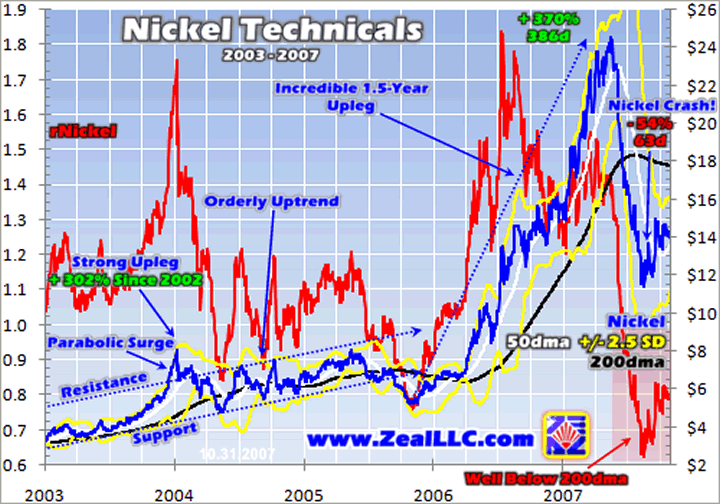
Nickel's bull actually began in late 2001. From its $2 low at the time to its May 2007 high over $24, nickel has at best been up an astonishing 1,100%+. Even at the apex of the late 2004/early 2005 base metals rally nickel was already outpacing the other metals and was up over 300% since the beginning of its bull.
And again like the rest of the base metals, nickel started its bull market in a rather orderly fashion. Now because nickel has a smaller market than the rest of the base metals, any shift on the fundamental and speculative fronts can cause prices to move fast in either direction. So the action inside the uptrend during the first few years of nickel's bull was quite a bit more volatile than it appears on this chart.
But the volatility through 2005 was nothing compared to that experienced in the subsequent years. In the last two years nickel has been on a roller-coaster ride that even a battle-hardened speculator might find queasy. Nickel's wild ride is visually apparent with a stunning dagger formation on the right side of its chart.
And nickel's actions reflect the epitome of price activity acting inversely to the movement of stockpile levels. Right about the time nickel hit its $5.22 low in late 2005, LME nickel stockpiles began to plunge. In just six months these stockpiles shed 89% to a disturbing low of 4k metric tons. This is the equivalent of only about one day of global consumption. After their freefall, LME nickel stockpiles flattened at this low point and stayed there for nearly a year until they finally turned the corner in May. Nickel production was simply not able to keep up with demand.
During this time nickel embarked on an incredible 386-trading-day upleg that saw it rise an astounding 370%. Nickel stockpiles were so low that an enormous risk premium was placed on the metal. Even the gun-slinging speculators were awestruck at $20+ nickel. And when the fundamentals changed, nickel buyers were few and far between as the speculators began to dump their nickel.
In May LME nickel stockpiles began an ascent that in recent weeks has taken them back up to their early 2006 levels. The result of this stockpile build is apparent on nickel's chart. As mentioned selling overwhelmed buying and nickel proceeded to crash hard. A big chunk of nickel's upleg gains were lopped off in a 63-trading-day selloff that saw the metal shed over half its price.
The selloff bottomed in August and since then nickel has seemingly stabilized. Today nickel is in the $14 range, which is still far above the launching point of the last upleg and over 600% higher than its 2001 low. Even with this recent major correction I believe nickel is still in its bull market. I'll certainly be watching LME stockpile levels closer now that we know the zone where the nickel market is really sensitive.
As mentioned previously the base metals complex indeed holds individual differences, but these metals also share many similarities from a strategic perspective. One commonality is that the base metals have experienced corrections and consolidations in the last year or so. This is all the base metals sans lead. Apparently lead did not receive this memo, as it has enjoyed a year of bountiful fortunes.
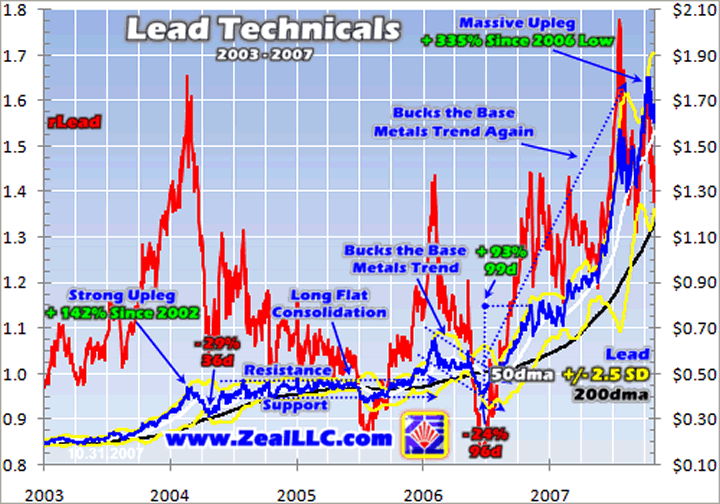
Long the pariah of the metals complex with its bumpy history, lead has taken the outside lane and blown past its peers to be one of the best-performing commodities in the entire global commodities bull market. Lead started its bull strong and began its ascent higher in late 2002. Its initial run was capped by a powerful upleg that shot its price past the highs of a decade ago gaining 142% before entering into a long consolidation stage.
From early 2004 through the end of 2005 lead was entrenched in a flat sideways-trending consolidation. And this consolidation proved that the markets accepted higher lead prices as it was trading on the high side of its previous upleg. And of course lead's actions up to this point were fundamentally driven.
Falling global lead stockpiles prompted the initial surge. Then flattening stockpiles ran in parallel with the flat prices through the end of 2005. In 2006 lead bucked the base metals trend. When the other base metals used the first half of 2006 to vault higher, lead actually trended lower and lost 24% in 96 trading days. And this was due to a direct inverse correlation to the fluctuation of its global stockpile levels. Measured by the LME, lead stockpiles mounted a brief six-month build.
In June LME lead stockpiles turned down again. And this sparked an inspiring rally that has seen lead crush previous highs and be one of the best-performing commodities of 2007. Since its June 2006 low, lead has skyrocketed 335% to its recent high just over $1.80. LME lead stockpiles have crashed in this period of time and just recently hit a shocking low of 20k metric tons, only one day of equivalent global daily consumption.
Now in the last couple weeks there has been a slight build of LME lead stockpiles. And lead's price has retreated a bit from its highs. I believe the fluctuation of lead stockpile levels in the upcoming weeks and months will be closely watched by the traders. A sizeable speculative risk premium is embedded into lead's price right now. So a continued build of lead's above-ground inventory would likely have a sharp adverse affect on its price.
Last and certainly not least of the major base metals is aluminum. Measured by volume aluminum is actually the king of the base metals. More aluminum is produced and consumed each year than copper, zinc, nickel and lead combined. But because its market is so huge, like a blue-chip stock, its volatility and excitement on the speculative front is boring compared to the other base metals.
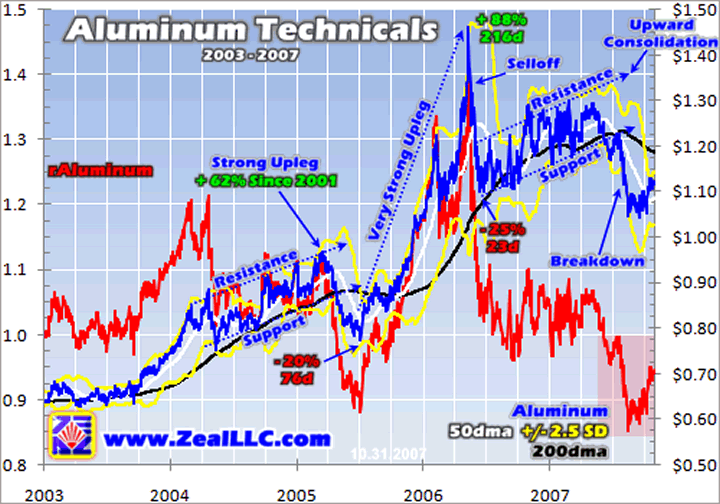
Aluminum's chart has a very similar look and feel to most of the base metals. The beginning of its bull started toward the end of 2001 and proceeded in a relatively orderly fashion. It was then capped by a strong 2003/2004 upleg and a subsequent upward consolidation. After a reprieve in the first half of 2005 aluminum was party to another strong upleg that broke its all-time highs and briefly flirted with the $1.50 mark. Most of this of course happened as global aluminum stockpiles were on the decline.
In May of 2006 aluminum touched its apex in speculative fashion and then sold off sharply with a 25% loss in only 23 trading days. Looking back, this selloff could be viewed as entering into the right side of a head-and-shoulders pattern. But the neckline was never pierced and aluminum eventually entered into a year long upward consolidation off its post-selloff bottom.
With LME aluminum stockpiles trending higher since the beginning of 2006, aluminum's upward consolidation through May 2007 was doomed to break to the downside. And indeed it has as aluminum has spent the better part of the last six months trading below its 200dma support.
Though aluminum's story seems similar to that of some of the other base metals, it has happened at a much weaker magnitude. Each of aluminum's upleg gains, correction losses, and bull-to-date gains is much smaller than the other base metals, hence its blue-chip nature. This metal has recently found a comfort zone in the $1.10 range and I suspect its price will continue to be at the mercy of its stockpile fluctuations.
After viewing the technical pictures of the five major base metals, it is apparent that high prices are here to stay. Coming off lows from the early 2000s the base metals have all entered into strong secular bull markets. And supported by smashingly bullish global fundamentals, the base metals technicals reveal a highly volatile yet lucrative market for speculative traders to relish.
Because of the wild volatility of the base metals markets, it is awfully difficult to discern any reliable technical trading patterns. But the technicals have shown us that whether the base metals are experiencing orderly uplegs or sharp parabolic ascents, their prices are ultimately strong and resilient. Even sharp corrections to blow off speculative exuberance still leave base metals prices at historically high levels.
And now five-plus years into the base metals bull markets, it is apparent that fundamentals are the key foundational drivers of today's technical market activity. Speculators indeed contribute to daily noise and cyclical extremes along the way, but these charts prove that the global dynamics of these commodities have drastically changed. The natural resources required to grow the global infrastructure build-out are truly hot commodities.
This base metals bull market is not only exciting for speculators in the futures markets, but also for stock traders. The companies that mine these metals have become wildly profitable in recent years as they sell their product at these elevated prices. And the stocks of these companies have been among the best performers in the entire stock market in recent years.
Even though base metals stocks have had incredible runs thus far, the good news is the party is not over. This bull market should last for another decade or so until the current supply/demand imbalance is reversed. And the mining companies tasked with building more mines and growing supply have quite a job on their hands.
Amazingly most base metals stocks are still well undervalued today. Profits have been growing so fast that even sharply rising stock prices have yet to outpace these companies' current and future valuations. At Zeal we have been researching and recommending base metals stocks to our newsletter subscribers for years. And these stocks have returned incredible realized and unrealized gains so far.
If you are interested in cutting-edge commodities market analysis and specific stock recommendations, subscribe today to our acclaimed Zeal Intelligence monthly newsletter. As a subscriber you also gain access to the extensive chart section of our website. These frequently-updated charts include unique near-term and long-term base metals charts in addition to the valuable stockpile charts.
The bottom line is the base metals technicals show very strong secular bull markets in each of these metals. These commodities have exhibited amazing uplegs that have vaulted their prices to historic highs. As consistently-increasing global demand continues to outpace supply, these bull markets should continue for many more years.
These technical charts have shown us that the base metals are very sensitive to fundamentals and because of their relatively small markets are vulnerable to wild speculative swings. Regardless of these swings, prices remain at levels that are immensely profitable for the mining companies that supply the markets. Stock traders can greatly leverage this bull market by investing in well-positioned base metals stocks.
By Scott Wright
So how can you profit from this information? We publish an acclaimed monthly newsletter, Zeal Intelligence , that details exactly what we are doing in terms of actual stock and options trading based on all the lessons we have learned in our market research as well as provides in-depth market analysis and commentary. Please consider joining us each month at … www.zealllc.com/subscribe.htm
Thoughts, comments, or flames? Fire away at scottq@zealllc.com . Depending on the volume of feedback I may not have time to respond personally, but I will read all messages. Thanks!
Copyright 2000 - 2007 Zeal Research ( www.ZealLLC.com )
Zeal_LLC Archive |
© 2005-2022 http://www.MarketOracle.co.uk - The Market Oracle is a FREE Daily Financial Markets Analysis & Forecasting online publication.



